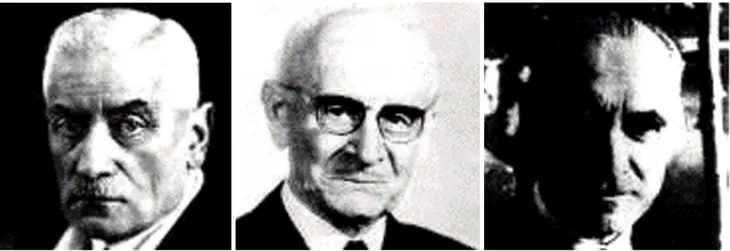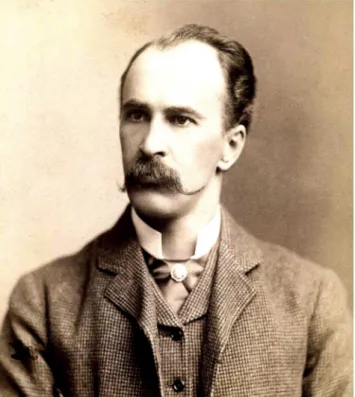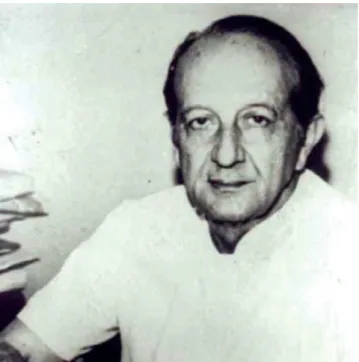600
https://doi.org/10.1590/0004-282X20170093
HISTORICAL NOTE
Guillain-Barré syndrome: celebrating a century
Síndrome de Guillain-Barré: celebração de um século
Marcos R. G. de Freitas1, Cecília M. Vidal1, Marco Orsini2
1Universidade Federal Fluminense, Hospital Universitário Antonio Pedro, Serviço de Neurologia; Rio de Janeiro RJ, Brasil; 2Universidade Severino Sombra, Programa de Mestrado em Ciências Aplicada em Saúde, USS, Vassouras RJ, Brasil.
Correspondence: Marcos R. G. de Freitas; Rua Gastão Ruch, 16 / apt 1402; 24220-100 Niterói RJ, Brasil; E-mail: mgdefreitas@outlook.com
Conflict of Interest: There is no conlict of interest to declare.
Received 25 February 2017; Received in inal form 10 May 2017; Accepted 16 May 2017.
ABSTRACT
A hundred years ago, Guillain, Barré and Strohl described a syndrome with a predominant motor acute or subacute polyneuritis, albumin-cytologic dissociation in the cerebrospinal luid, and a benign course. Before them, many other authors, such as Landry, Duménil, Osler, and Grainger Stewart had described similar cases although they had not performed lumbar punctures. In this work, we outline certain features of the beginning of this famous syndrome.
Keywords: Guillain-Barre syndrome; neuritis
RESUMO
Há 100 anos três médicos franceses, Guillain, Barré e Strohl descreveram um tipo de polineuropatia aguda ou subaguda de predomínio motor com dissociação albumino-citológica no líquido cefalorraquiano e de evolução benigna. Antes destes, outros autores, como Landry, Duménil, Chomel, Osler e Grainger Stewart, estudaram casos similares, porém não realizaram punção lombar. Neste trabalho procuramos sintetizar alguns fatos importantes no início da descrição desta síndrome.
Palavras-chave: síndrome de Guillain-Barré, neurite.
In 2016, a century had passed since the famous descrip-tion of a syndrome of an acute, ascendant and sym-metrical paralysis involving the peripheral nerves with an albumin-cytologic dissociation in the cerebrospinal
luid and a good recovery, by three French neurologists: Guillain, Barré and Strohl. his syndrome, well known as
“Guillain-Barré syndrome”, is the most common cause of
acute laccid paralysis in the world. In June 2016, a sympo -sium in Glasgow celebrated a century of Guillain-Barré
syn-drome, patronized by the Peripheral Nerve Society1.
Guillain-Barré history
In 1916, Georges Charles Guillain, Jean Alexandre Barré and André Strohl (Figure 1) described in Bulletins et Mémoires de la Société Médicale des Hôpitaux de Paris2,
a new syndrome in two young French soldiers character
-ized by motor disturbance, abolition of the tendon reflex,
paresthesia with mild disturbance of sensation, slight changes in electric reaction of nerves and muscles and hyperalbuminosis of the cerebrospinal fluid with absence
of cytological reaction (albumin-cytologic dissociation).
The cases were presented at the Medical Society of the Hospitals in Paris on October 16th 1916, under the title “Sur un syndrome de radiculonévrite avec hyperalbuminose du
liquide céphalorachidien sans reaction cellulaire. Remarques sur le caractères cliniques et graphiques des réflexes tendin-eux” (Figure 2). They thought that this syndrome was due
to involvement of the spinal roots and nerves, probably
infectious or toxic in nature. The treatment consisted of
rest, massage and injections of strychnine. Both patients recovered after a few months.
Guillain became professor of Neurology at the Salpêtrière Hospital in Paris. Barré was professor of Neurology at
Strasbourg. hey became friends at the “Centre Neurologique”
of the 6th army near Amiens during the irst world war, which
is where they saw these cases3. Strohl was forgotten, probably
because of his young age and his participation was limited to electrophysiology.
Early description
In 1850, Jean Baptiste Octave Landry de Théizillat (1826-1865) (Figure 3) wrote “Note sur la paralysie ascen -dante aigue” where he reported on 10 patients, five of whom
he had personally examined4. He described three types of
presentation: ascending paralysis without sensory signs
601
Freitas MRG et al. Guillain-Barré syndrome
man, after a premonitory fever, complained of “weakness,
tingling his fingers and toes”. Touch sensation was lost in the fingers and feet but was little impaired in the upper two thirds of the lower limbs. The paralysis ascended, with
sensory loss. By the third week, his limbs were paralyzed,
he developed difficulty in breathing and swallowing, with fever and coughing. Touch was lost in the feet and in the finger tips, but without pain and temperature loss. He died
in the third week. Necropsy included histological exami -nation only of the cord and soleus muscle. The main dif-ference between that report and the syndrome described
by Guillain, Barré and Strohl was that Landry did not
perform a lumbar puncture, as this was introduced by
Quincke only in 1891.
Landry was a gentle and modest man. At the age of 40,
while attending the victims of a cholera epidemic in Paris,
Figure 1. Georges Charles Guillain (1876-1971), Jean Alexandre Barré (1880-1967) and André Strohl (1887-1977).
602 Arq Neuropsiquiatr 2017;75(8):600-603
Landry contracted the illness and died a few days later5.
Haymaker called this syndrome the “Landry-Guillain-Barré syndrome” and included the name of Landry as one of the
fathers of Neurology6. Landry’s description probably included
all types of acute or subacute ascending paralysis, such as some cases of poliomyelitis or ascending myelitis. In 1864,
Louis Stanislas Duménil, in Rouen, described one case of
an acute and symmetrical ascending paralysis. He thought
it was due to nerve atrophy. hree years later he described
three other cases1.
Sir William Osler (1849-1919) in “he Principles and Practice of Medicine” (Figure 4) wrote about an ascending
paralysis he referred to as an acute infectious polyneuritis3.
Guillain and Barré did not accept that description, as Osler’s
patient had fever in the beginning of the disease and had no lumbar puncture7.
In Paris in 1828, Auguste François Chomel (1788-1858)
described a patient with disturbed sensations in their hands
and feet, ascendant weakness with acute evolution, becom -ing paralytic within a few days1. In 1881, homas Stewart
(1837-1900), in Edinburgh, reported on three cases of that same illness, calling attention to the loss of tendon relexes1.
Soon after 1916
Draganesco and Claudian were the irst to use the term
“Guillain-Barré syndrome” in 19271.
In 1936, Guillain published ten nonfatal cases and
established the main conditions of this syndrome: 1) albumin-cytologic dissociation in the cerebral spinal luid; 2) onset with paralysis and paresthesia or pain, with or with
-out premonitory symptoms; 3) laccid paralysis of the lower limbs and later in the upper limbs; 4) occasional ibrillatory twitching and slight atrophy of the distal muscles; 5) abolition
of tendon relexes; 6) presence of subjective sensory distur
-bance; 7) objective minor or transitory changes in sensibil
-ity; 8) transitory paralysis of the cranial nerves; 9) transitory
sphincter disturbance8.
In the same year, Alajouanine published a similar case in
which death had occurred9.
Guillain and Barré7 refused to accept the cases described
without albumin-cytologic dissociation in the cerebral
spi-nal luid, and in the cases with fatal outcome, Landry and Alajouaninewere the objects of attack by Guillain1,3. Firstly Figure 4. Willian Osler (1849-1919).
603
Freitas MRG et al. Guillain-Barré syndrome
because they did not mention the albumin-cytologic
dis-sociation in the cerebral spinal luid, and secondly, because
the patients died from the disease. Two years later, Guillain accepted that this syndrome could be fatal3.
he irst case in Brazil was described by Antonio Rodrigues de Mello (Figure 5) in a soldier who, without
prodromal symptoms, presented with a subacute ascend-ing paralysis, slight sensory disturbances in the limbs with
paralysis of the trigeminal and facial nerves. he cerebral spi
-nal luid showed an albumin-cytologic dissociation. He was
treated with intravenous and intrathecal vitamin B and
recovered in a few weeks. Mello believed that the disease was due to lack of vitamins or due to a neurotrophic virus10.
Conclusion
he history of Guillain-Barré syndrome continues today.
Many advances have been made in the epidemiology, clinical
variants, atypical cases, electrophysiology indings, patho -genesis, preceding infections and vaccinations, nerve images,
treatment and rehabilitation. hese are another story.
References
1. Philippon J, Léger JM. GBS:The early Years in Paris. In: Willison HG, Goodfellow JA. GBS 100. Narberth: GBS/CIDP Foundation International; 2016. p. 10-4.
2. Guillain G, Barré, JA, Strohl. Sur un syndrome de radiculonévrite avec hyper-albuminose du liquide céphalo-tachidien sans réaction cellulaire. Remarques sur les caractères cliniques et graphiques des rélexes tendineux. Bul Mém Soc Med Hôp Paris.1916;40:1462-70. 3. Ropper AH, Wijdicks EFM, Truax BT. Guillain-Barré syndrome.
Philadelphia: FA Davis; 1991. History of Landry-Guillain-Barré syndrome; p. 3-17.
4. Landry O. Note sur la paralisie ascendent. Gaz Hebd Méd Chir. 1859;6:472-74,486-88.
5. Pearce JMS. Octave Landry’s ascending paralysis and the Landry-Guillain- Barré syndrome. J Neurol Neurosurg Psychiatry. 1997;62(5):495, 500.
6. Haymaker W. Octave Landry (1826-1865). In: Haymaker W, Schiller F. 2nd ed. Springield: Charles C Thomas; 1970. p. 466-9.
7. Guillain G, Alajouanine TH, Pérrison J. Sur le syndromede radiculo-névrite aigue curable avec dissociation albumino-cytologique du liquide cephalo-rachidien (deux observations). Rev Neurol (Paris).1925;41:492-6.
8. Guillain G, Barré JA. Quelques remarques sur notre ”Syndrome de radiculo-névrite avec hyperalbuminose du liquide céphalo-rachidien sans réaction cellulaire”. Rev Neurol (Paris). 1936;65:573-82. 9. Alajouanine Th, Thurel H, Hornet TH, Boudin G. La poliradiculo-névrite
géneralisée avec diplégie faciale et paralysie terminale des muscules respiratoires et avec dissociation albumino-cytologique: étude anatomique. Rev Neurol (Paris).1936;65:681-9.
10. Mello AR. Acerca das poly-radiculo-neurites generalizadas com dissociação albumino-cytologica. Brasil-Medico.1939;41:951-4.


